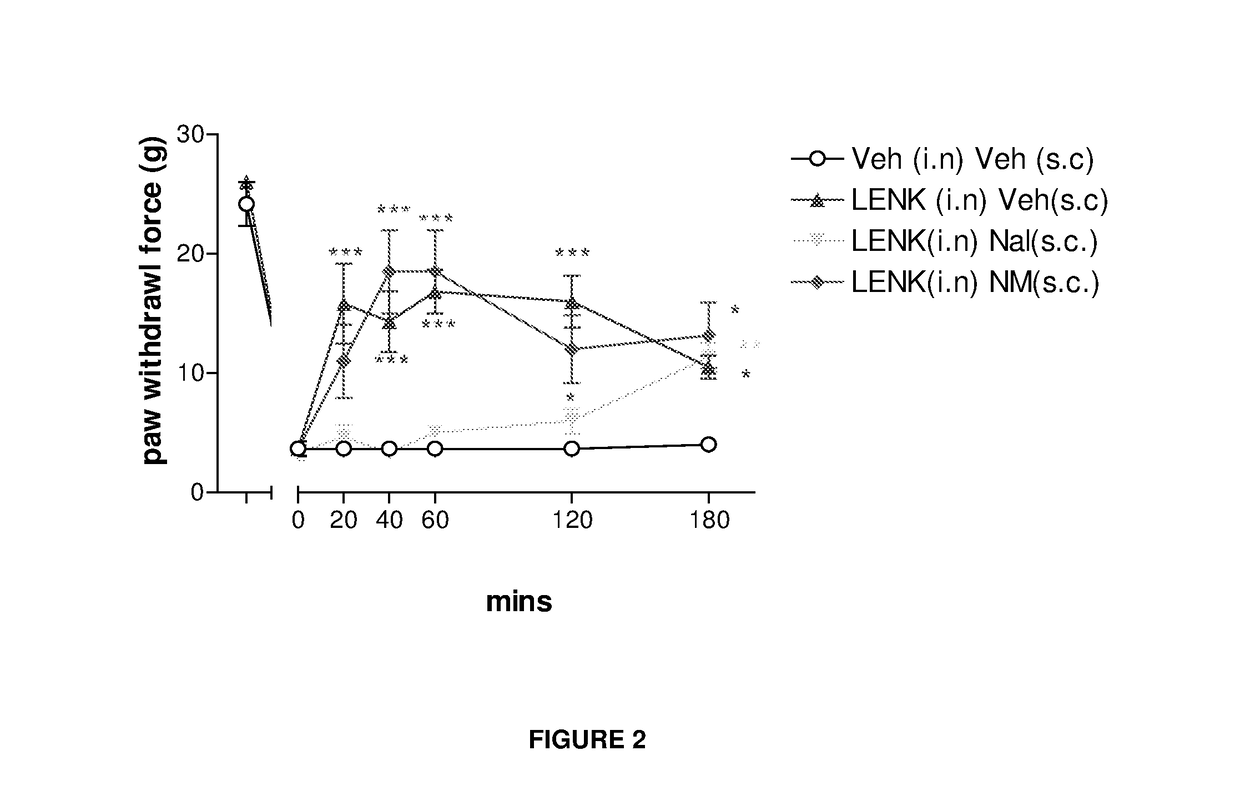Delivery of drugs
a drug and intranasal delivery technology, applied in the field of drugs delivery, can solve the problems of cell leakage and therefore toxicity, limited treatment of brain diseases, and physical disadvantages of nasal administration that must be overcome, and achieve the effect of enhancing delivery and greater association
- Summary
- Abstract
- Description
- Claims
- Application Information
AI Technical Summary
Benefits of technology
Problems solved by technology
Method used
Image
Examples
example 1
Synthesis of Quaternary Ammonium Palmitoyl Glycol Chitosan (GCPQ) Acid Degradation of Glycol Chitosan
[0066]Glycol chitosan (2 g) was dissolved in hydrochloric acid (4M, 150 mL) for 20 mins a room temperature under constant stirring. The solution was placed in a preheated water bath at 50° C. At 8 hr the reaction was stopped and the product was removed from the shaking water bath. Molecular weight was controlled by degradation time, i.e. increasing the acid degradation time decreased the molecular weight of the resulting polymer. Previous work has shown that a molecular weight of 13,000 Da was obtained after 8 hr of acid hydrolysis of glycol chitosan with a starting molecular weight of approximately 100,000 Da. The product was purified by exhaustively dialysing (Visking seamless cellulose tubing, molecular weight cut off of 7,000 Da) against deionised water (5 L) with six changes over 24 hr. The dialysate at the end of the dialysis procedure (neutral pH) was subsequently freeze-dried...
example 2
n of Invention with Prior Art
Methods
Trimethylchitosan Synthesis 2-Step Reaction (Prior Art)
[0092]Two step synthesis was carried out using essentially the same method as reported by Sieval, A. B., et al., Preparation and NMR characterization of highly substituted N-trimethyl chitosan chloride. Carbohydrate polymers, 1998. 36(2-3): p. 157-165. Briefly 2 g chitosan (Sigma, UK) was suspended in 80 ml of 1-methyl-2-pyrrolidinone in 3 neck flask, in a stabilised oil bath at 60° C. under reflux. Sodium iodide (4.8 g) was dissolved in 11 ml of NaOH (15%, 3.84M) and added to the chitosan. The system was purged of air with nitrogen prior to the addition of methyl iodide (11.5 ml) and reacted for 1 hr. The product was precipitated with ethanol and thereafter isolated by centrifugation (2000 rpm at 6° C. for 3 min). The product was placed in a vacuum filter and washed twice with ether (300 ml total) to remove all the ethanol until it was quite dry. The product was then resuspended in NMP (80 ml...
PUM
| Property | Measurement | Unit |
|---|---|---|
| mean particle size | aaaaa | aaaaa |
| molecular weight | aaaaa | aaaaa |
| molecular weight | aaaaa | aaaaa |
Abstract
Description
Claims
Application Information
 Login to View More
Login to View More - R&D
- Intellectual Property
- Life Sciences
- Materials
- Tech Scout
- Unparalleled Data Quality
- Higher Quality Content
- 60% Fewer Hallucinations
Browse by: Latest US Patents, China's latest patents, Technical Efficacy Thesaurus, Application Domain, Technology Topic, Popular Technical Reports.
© 2025 PatSnap. All rights reserved.Legal|Privacy policy|Modern Slavery Act Transparency Statement|Sitemap|About US| Contact US: help@patsnap.com



